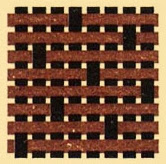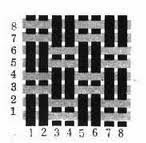The interweaving of fabrics is made by using natural fibers, chemical fibers or various blends of different fibers. The straight yarns on the fabric surface are called warp yarns, the horizontal yarns are called weft yarns, and the interlacing of warp and weft yarns is called fabric weave. Due to the different ways of interweaving fabrics, it can be divided into two categories: woven fabrics and knitted fabrics.
The woven fabric, also known as parallel fabric or woven fabric (as it is customary in mainland China), is a fabric made up of parallel warp yarns and parallel weft yarns interlaced at right angles. Compared with knitted fabrics, woven fabrics are generally less elastic (without elastic fibers), but good at abrasion.
The woven use:
Woven fabrics are widely used in life, such as shirts, suits, jeans, sheets, curtains, pillowcases, waterproof jackets, jacket linings, cloth bags, cloth suitcases, and so on.
Woven fabrics can be divided into three types: plain weave, twill weave and satin weave according to the different weft and warp yarn interlacing points.

Plain Weave
The weave concept of plain weave of plain weave is shown on the right.
Plain weave is the simplest one among various weaves. For example, when four transverse warp yarns and four straight weft yarns are interlaced with each other, each warp yarn and weft yarn will have four interlacing points.
On the basis of the original plain weave, increase or decrease the number of interlaced fulcrums, or move the position of the original weave, or when both are performed at the same time, the plain weave can be changed.
The variations of plain weave cloth include:

Mat, Basket or Hopsack Weave
- Wrap Rib Weave
- Weft Rib Weave
- Fancy Rib Weave
- Figured Rib Weave
- Oblique Rib Weave
- Mat, Basket or Hopsack Weave
- Fancy Mat Weave
Twill Weave
The warp and weft yarns of the twill weave are not continuously interlaced up and down, but the warp yarns sometimes continuously float (on the surface) above two or more than two weft yarns, or continuously sink (under the surface) two or more weft yarns Below. Finally, the surface of the fabric will be diagonally staggered to form diagonal lines.
When the number of floats of the twill fabric is not equal or the number of configurations is different, the texture of the front and back sides of the composed twill fabric must be different. This kind of twill fabric with different textures on both sides is called Uneven Sided Twill. In addition, if the number of warps and wefts on both sides of the fabric are the same in configuration and circulation, the textures on the front and back sides of the twill fabric will be the same except for the diagonal directions. This kind of organization is called Even Sided Twill.
The variations of twill weave cloth include:
- Steep Twill or Diagonals
- Reclining Twill
- Curved Twill
- Broken Twill or Cross Twill
- Fancy Twill
- Mixed Twill or Compound Twill
- Corkscrew Twill
- Entwing Twill
- Checked Twill or Dice Twill
- Point Twill
- Diaper Twill
- Shaded Twill

The above icons from left to right are: normal twill, curved twill, clipped twill, mixed twill, net twill, mountain twill, diamond twill and shaded twill
Satin Weave or Sateen Weave
The points of the satin weave are not continuous, but are scattered in the fabric weave at an average distance. There is only one staggered weave point in each warp or each weft in the fabric structure. Therefore, among the three types of plain weave fabrics, the surface of the satin weave is particularly smooth and bright, but the wear resistance is weak.
Variations of satin weave cloth include:
- Double Satin
- Granite Weave
- Irregular Satin
- Checked Satin
- Shaded Satin
In addition, other special organizations whose appearance or structure cannot be classified into the top three categories include:
- Honey Comb Weave
- Brighton Honey Comb Weave
- Sponge Weave
- Huckaback Weave
- Imiation Gauge or Mock Leno
- Spider or Linear Zigzag Weave
Reprinted information from http://acotex.blogspot.com/2013/11/wovenfabric.html